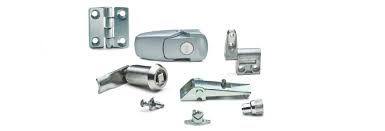Open the Door to the World of Access Solutions with Bossard
No matter your industry or segment, protecting what needs to be protected is critical. And when it comes to different access locking and control solutions, the team at Bossard can and will help. Our seasoned team of access locking and control engineers specialize in helping other engineers and product developers create more secure and reliable solutions.
Let’s take a quick look at a few key types of access locking and control solutions. To see these mechanisms in action in everyday scenarios, watch our latest video: Access Solutions from Bossard.
What Is a Cam Latch?
The cam latch is a relatively simple locking mechanism designed to secure access to entry points and panels. Cam latches are made up of a latch and body that rotates when actuated to release or secure.
What Are Draw Latches and Hinges?
Draw latches function by leveraging the simple principle of drawing two parts or items together by using tension. The key parts of a draw latch assembly are:
- The blade, which can be a wire-formed loop, hooked plate, or another mechanism.
- The keeper, which is a hooked plate engineered to receive the blade.
- The hinge, which is discussed in more detail below.
With a draw latch, the tension is established when the blade is connected to the keeper and then clamped down. For most draw latches, the tension is released as the latch is rotated into a vertical position; while the horizontal position usually results in tension being applied.
What is a Friction Hinge?
The friction hinge — also called a torque hinge — is an important access locking and control solution designed to provide resistance to the pivoting motion of the hinge. These mechanisms are used for holding doors, lids, panels, and display devices at certain angles for long periods.
What is a Gas Spring?
Also called the pressure gas spring, gas pressure damper, and gas damper, gas springs are designed to solve simple to complex requirements for closing, opening, tilting, and damping tables, flaps, loungers, or seats. Unlike other mechanical springs that use elastic deformation, gas springs rely on compressed gas located inside an enclosed cylinder that is sealed with a sliding piston that pneumatically stores potential energy. At the same time, this design enables the gas spring to withstand external forces applied parallel to the direction of the piston shaft.
Contact Bossard for Customized Access Solutions
At Bossard, we are your experienced manufacturing partner. We are home to a vast range of tailored access solutions designed for an array of applications.
Don’t hesitate to reach out to us today for solutions or guidance at india@bossard.com and feel free to watch our latest YouTube video - Access Solutions from Bossard — to see many of our actual access and locking solutions in everyday scenarios.


%20(1).jpg)

Comments
Post a Comment